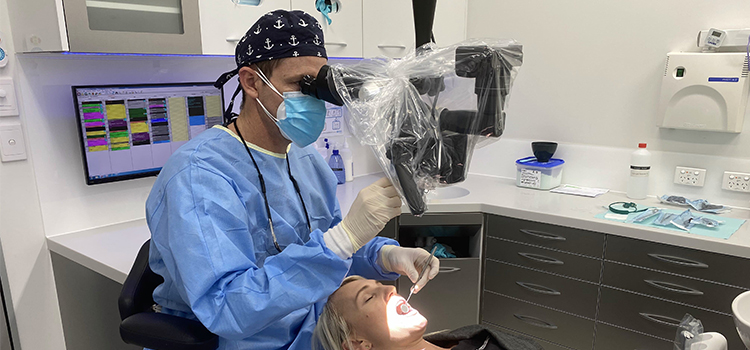Microscopic Dentistry
December 2, 2020
In dentistry, there are many benefits of using a dental microscope. Much of what we do requires us to visualise fine details within our patients mouths and work with a high degree of accuracy. For this reason, you may have noticed dentists wearing special magnifying eyeglasses called loupes, which provide a more zoomed-in, detailed view whilst working.
However, the ultimate magnification is delivered by the dental operating microscope. This microscope provides a:
- Wider field of view
- Deeper depth of focus
- Superior illumination of the mouth

If you are unfamiliar with dental microscopes, our team has outlined what they are, the benefits they may provide to your dentist, and why they are important in dentistry.
What is microscopic dentistry?
The dental microscope is a high-tech piece of equipment that is similar in appearance to a desktop stereo microscope, but has a number of additional features. It is usually mounted to the wall or ceiling by a movable arm so that it can be moved over the patient’s head whilst they lie in the dental chair, and provides a clear view into their mouth.
A bright LED light attached to the scope provides shadow-free illumination of the mouth and various controls allow the dentist to:
- Change the magnification level
- Fine tune the focus
- Turn filters on when performing different procedures
- Take pictures or videos during the procedure for patient education
Benefits of a dental microscope
There are many benefits of using a microscope for dentistry, from the increased magnification to the illumination that a dental microscope can provide. Some of the benefits include:
Different levels of magnification
Dental microscopes offer a range of magnification levels typically ranging from 2x to 30x. With the turn of a dial, the dentist can easily zoom in and out on different structures in the mouth. This is very important as different procedures in dentistry often require different levels of magnification.
Illumination
The mouth is a dark, shadowy place to work and shining a light in at the right angle to work effectively can be challenging to say the least. A huge advantage of dental microscopes is their bright co-axial light source. Because the light is on the same axis as where the dentist is looking, the mouth is always illuminated perfectly without shadowing.
Early diagnosis
As is often the case in any medical field, early detection of health problems leads to improved outcomes. The enhanced vision of the dental microscope means that issues such as cracked teeth, dental decay and gum disease can be detected at an earlier stage.
As a result, these issues can be treated conservatively before they become a major problem.
Precision
The magnified view provided by the microscope allows the dentist to see much finer details. This in turn helps to improve the accuracy of tooth preparations and ensures that fillings and crowns fit more precisely. Furthermore, it can also improve aesthetics as fillings and veneers can be polished to a finer finish.
Ergonomics
Rather than leaning over to visualise patient’s mouths, the dental microscope allows your dentist to sit in a comfortable, upright position whilst working. This reduces back and neck strain significantly, meaning the dentist can work more efficiently.
It may even extend their career, as unfortunately many dentists have been forced into early retirement due to neck and back issues.
Patient education
The microscope is connected to a live video which is displayed on the ceiling monitor so that you can see what the dentist sees. This results in a better understanding of what the dentist is doing and explaining to you. Furthermore, it can even allow you – if you are curious – to view the whole procedure.
Root canal treatment
The dental microscope allows the dentist to locate, clean and fill extra canals and spaces within a tooth that may otherwise have been missed.
The improved magnification and light provided by the microscope also allow the treatment of blocked or calcified canals.
In addition, root canal treatment may be performed more conservatively when using a microscope. This ensures that minimal tooth structure is removed during your treatment. All these factors may help to increase the chances of a successful outcome for root-treated teeth.
Other procedures
Apart from root canal treatment and pulp therapy, you may find your dentist using a microscope for treatments such as:
- Patient examinations
- Restorative procedures
- Crown preparations
- Cosmetic procedures e.g. veneers
- Treatment of gum disease
- Oral surgery
- Dental implants
Book an appointment
If you would like to know more about how we use dental microscopes in our practice, or think you may need a root canal treatment, contact our friendly staff today.
Alternatively, you can book an appointment online 24/7.















